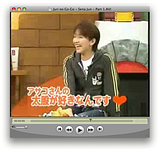I've been a fan of the
Takarazuka Revue Company for several years now and have not only been fascinated by the incredible productions, in which all roles are played by women (those who play male roles are called "otokoyaku," those who play female roles are called "musumeyaku," and "Top Stars" are the "stars" of each troupe), but also the variety and talk shows that the actresses, called Takarasiennes instead, choose to visit.
As I was going through some videos from several years ago, I found a number of different examples in the usage of katakana, particularly in the show "Juri no GoGo5!" It's hosted by a former Takarazuka otokoyaku, stage name Juri Sakiho (hence the title of the show) and her guests are usually Takarazuka Top Stars and some members of their troupe. Juri-san makes a great host because of her sense of humor and her likeable personality - it always sets her guests at ease, creating a really comfortable environment that almost always leads to silliness but also to very candid and enlightening stories. Because of the former - the silliness that occurs - there are always captions that highlight a funny exchange. In these captions, I noted that katakana was used many times, usually as an onomatopoeia or for foreign words. (Words most commonly put into katakana were the hair products promoted on the show, such as VO5 スパー ハード ヘア スプレー "VO5 Super Hard Hair Spray.")
However, there were two examples that I noted that did not fit under the category of onomatopoeia nor foreign word.
Example 1: Animal name, タコの人, "octopus person", Japanese TV show "Juri no GoGo5"

(Click to enlarge)In this example, the guests had been asked to describe some quality of their Top Star, Aran Kei, pictured above. One of the shows she had done was "El Halcon," a musical on pirates based on the Aoike Yasuko manga of the same name. The movie "Pirates of the Caribbean" came up in the ensuing conversation and in this screencap, Aran Kei was teasing her troupe members by implying that they thought of her as the "octopus person," Davy Jones.
At first, I had thought that the reason why タコ was used instead of たこ was because it was combined with 人 and thus created something that was fantastical and not real, thus falling into the category of "foreign word." However, after speaking with Park-sensei, I learned that animal and plant names are often written in katakana (i.e. バラ for "rose"). In this way, katakana is used to show when one is speaking generically about an animal, as opposed to a specific type (i.e. umbrella octopus) which would most likely have hiragana/kanji.
Example 2: Nickname, アサコ, "Asako", Japanese TV show "Juri no GoGo5"

(Click to enlarge)This example features Sena Jun, former top star of Yukigumi (Moon Troupe) and requires a little background on the Takarazuka Revue's practice in regards to names. During their time at the Takarazuka Revue Company, all Takarasiennes are known only by their stage names. Personal information such as their real name and age are actually kept secret (part of what falls under what is called the "Sumire Code") until a Takarasienne's retirement. Sena Jun retired in 2009 and her real name, Doi Asako (土井麻子), has since been released to the public.
Nicknames, however, can be derived by either a Takarasienne's real name (Sena Jun's nickname: Asako), stage name (Juri Sakiho's nickname: Juri) or something else entirely (Takumi Hibiki, former top star of Hanagumi [Flower Troupe]: Charlie, because of her bicycle). In this example, the caption is of Juri's words of praise for Sena, but she uses Sena's nickname, "Asako." I was surprised to see it written アサコ instead of あさこ simply because it's a common female name. I at first thought that because of Takarazuka's policy that Takarasiennes primarily go by their stage names, the use of katakana denoted the name as "unofficial" and linked to "foreign." However, speaking again with Park-sensei revealed that it was because her real name uses kanji and not hiragana (麻子).
The above examples show that it can be quite difficult to place definitive rules on the usage of katakana. This can explain why textbooks may explain this usage of katakana in different ways. Most note that katakana is often used for foreign words and onomatopoeia, however, some add reasons why they are used. For example, the last excerpt from our handout notes that "foreign loanwords give an impression of sophistication and modernity" and are used "even when a perfectly good native Japanese word exists." Another example spoke of the use of katakana as onomatopoeia that can both express "natural sounds (
meow, bang, etc.)" and "manner (
twinkle, zigzag, etc.)."
Using the information learned from the above examples, it seems that katakana can also be used to denote "general" concepts, as in the タコ example, and "informality," as in the アサコ example. This shows that even though the above examples at first seem to fit in the general katakana usage rules (namely "foreign words"), further investigation reveals that there are more intricate reasons at work. These examples along with the differences in explanations seen in textbooks show that the deliberate use of katakana can reveal deeper meanings. Knowing these subtle differences is very useful to one's learning of Japanese, adding a depth to one's understanding of katakana's role in Japanese language and culture.







